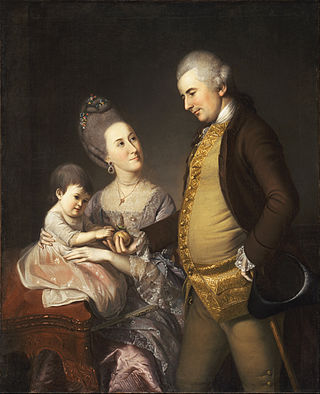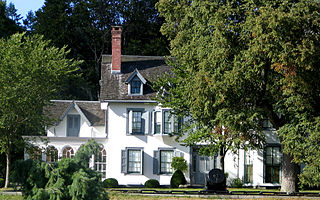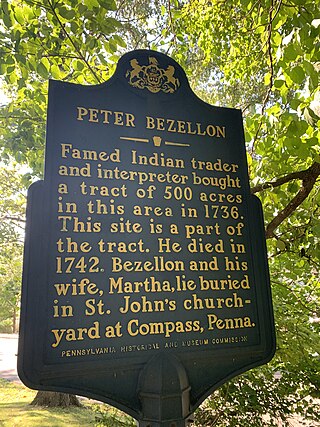Related Research Articles

John Penn was an English-born colonial administrator who served as the last governor of colonial Pennsylvania, serving in that office from 1763 to 1771 and from 1773 to 1776. Educated in Britain and Switzerland, he was also one of the Penn family proprietors of the Province of Pennsylvania from 1771 until 1776, holding a one-fourth share, when the creation of the independent Commonwealth of Pennsylvania during the American Revolution removed the Penn family from power.

John Cadwalader was a commander of Pennsylvania troops during the American Revolutionary War and served under George Washington. He was with Washington at Valley Forge.

Thomas Willing was an American merchant, politician and slave trader who served as mayor of Philadelphia and was a delegate from Pennsylvania to the Continental Congress. He also served as the first president of the Bank of North America and the First Bank of the United States. During his tenure there he became the richest man in America.

Major-General James Clinton was a Continental Army officer and politician who fought in the American Revolutionary War.

Simeon De Witt was Geographer and Surveyor General of the Continental Army during the American Revolution and Surveyor General of the State of New York for the fifty years from 1784 until his death.

Robert Erskine (1735–1780) was a Scottish inventor and engineer who came to the British colonial Province of New Jersey in 1771 to run the ironworks at Ringwood, New Jersey. He subsequently became sympathetic to the movement for independence. In 1776 during the American Revolutionary War he designed an underwater cheval-de-frise that was installed across the Hudson River at the north end of Manhattan to prevent passage of British ships upriver.
Thomas Hutchins was an American military engineer, cartographer, geographer and surveyor. In 1781, Hutchins was named Geographer of the United States. He is the only person to hold that post.
The Great Wagon Road is a historic trail in the eastern United States that was first traveled by indigenous tribes, and later explorers, settlers, soldiers, and travelers. It extended from British Pennsylvania to North Carolina, through the Great Appalachian Valley, and from there to Georgia.

Thomas Jefferys, "Geographer to King George III", was an English cartographer who was the leading map supplier of his day. He engraved and printed maps for government and other official bodies and produced a wide range of commercial maps and atlases, especially of North America.

John Erskine (1721–1803), the Scottish theologian, was born near Dunfermline at Carnock on 2 June 1721. His father was the great Scottish jurist John Erskine of Carnock and his grandfather was Colonel John Erskine of Cardross who had been in William of Orange's army when it invaded England in the Glorious Revolution of 1688.

Adamson Tannehill was an American military officer, politician, justice of the peace, U.S. Congressman, Pennsylvania state representative, and civic leader. Born in Frederick County, Maryland, Tannehill was among the first volunteers to join the newly established Continental Army during the American Revolutionary War, serving from June 1775 until 1781. He attained the rank of captain and was commander of the Maryland and Virginia Rifle Regiment, the longest-serving Continental rifle unit of the war. He participated in several prominent engagements, including the battles of Trenton, Princeton, and Saratoga, and the Brodhead Expedition of the war's western theater. After the conflict, Tannehill settled in Pittsburgh, Pennsylvania, his last military posting of the war. He was active in the Pennsylvania state militia, rising to the rank of major general in 1811. Tannehill also served as a brigadier general of United States Volunteers on the Niagara Frontier of the War of 1812.
The 5th General Assembly of Nova Scotia represented Nova Scotia between May 1770 to 1784, its membership being set in the 1770 Nova Scotia general election.

Richard Penn Sr. was a proprietary and titular governor of the Province of Pennsylvania and the counties of New Castle, Kent, and Sussex, which then included present-day Delaware. He served as governor from 1746 to 1771. His father was William Penn, founder of the colonial-era Province of Pennsylvania, one of the original Thirteen Colonies in British America

Peter Bisaillon, was a New France fur trader and interpreter who spent most of his career in Pennsylvania engaged in trade with Native American communities. Bisaillon and other coureurs des bois dominated the Pennsylvania fur trade during the late 17th and early 18th century, as they were skilled hunters and trappers and had established good relations with local Native American tribes. Bisaillon and his colleagues were regarded with suspicion by Pennsylvania authorities, however, and he was frequently accused and jailed on false or minor charges. He was eventually forced out of the fur trade, but retired a wealthy man.
Richard Parker was an American colonel who fought in the American Revolutionary War. Son of prominent Virginia jurist Richard Parker, Parker received an officer's commission in a Virginia regiment early in the conflict. He probably was present at Great Bridge and Norfolk. Promoted to major, he fought at Trenton in December 1776 and commanded the regiment at Second Trenton and Princeton in January 1777. At Brandywine in September 1777 he led a detachment of light infantry in delaying the British. The next month he fought at Germantown. Promoted to colonel at Valley Forge, he led a picked detachment at Monmouth in June 1778. In May 1779, George Washington ordered him back to Virginia to recruit a new regiment. After being sent south with a new unit of reinforcements for Charleston, South Carolina in late 1779, he died of wounds received at the Siege of Charleston in 1780.

Nicholas Scull II (1687–1761) was an American surveyor and cartographer. He served as Surveyor General of Pennsylvania from 1748 to 1761.
References
- ↑ Gruthorn, Peter J. 1966. American Maps and Map Makers of the Revolution. Monmouth Beach, NJ: Philip Freneau Press. Page 32
- ↑ Bell, Whitfield J., and Charles Greifenstein, Jr. Patriot-Improvers: Biographical Sketches of Members of the American Philosophical Society. 3 vols. Philadelphia: American Philosophical Society, 1997, 2:227–231.